| Vintage Pulp | May 30 2013 |

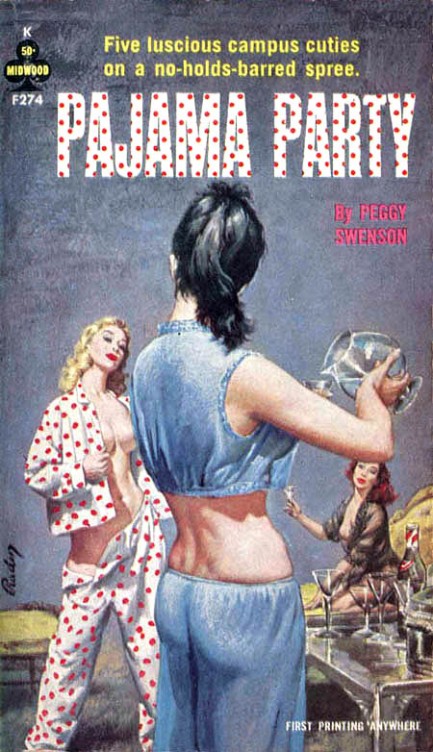
Above is a cover for 1963’s Pajama Party, a book written by Peggy Swenson, who was in reality Richard E. Geis. Interesting fellow, Geis—he specialized in beatnik and counterculture sleaze, churning out lightweight novels like Bongo Bum, Beat Nymph, and Like Crazy, Man, and was indicted for obscenity over a novel called Three-Way Apartment. This was in 1964. Geis went to trial twice, first in California, then in federal court in Iowa. He was convicted but the case made its way to the U.S. Supreme Court where the panel overturned the verdict, thus making Geis’s Three-Way Apartment one of those forgotten but important books that helped free publishing from the grip of reactionary prudes.
After Geis’s close call with the feds he must have felt artistically liberated, because his writing promptly went to the far ends, so to speak, of taste. Some titles: Anal Husbands and Deviant Wives, The Endless Orgy, Women and Bestiality, and, our two favorites—Orality ’69 and its sequel Orality ’70. Pajama Party was not so notable a book as those—five co-eds have a sleepover that involves a pillow fight, skinny-dipping, a striptease contest and a game of dares, before finally getting down to a little Sapphic lust—but we really like the Paul Rader cover, so there you go.
| Vintage Pulp | Sex Files | Apr 2 2012 |

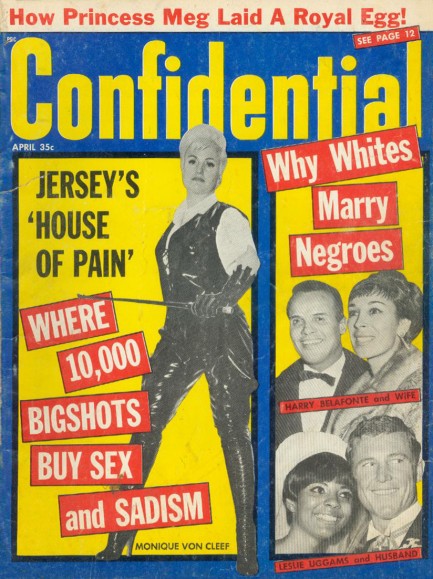
In December 1965 in Essex County, New Jersey, local police raided a large home on 850 Lake Street in suburban Newark where they suspected illegal sexual activity was taking place. A detective entered first and met the house’s owner, a Dutch-born former nurse named Monique Von Cleef. The two had reached the point where she had donned a leather jumpsuit and he had stripped to his boxer shorts. At that moment the cops that had been waiting outside stormed into the house. They found that the entire three-story building had been set-up to service practitioners of sado-masochism. Von Cleef had been running the place for years, and had made a nice business out of punishing submissives—among them doctors, local officials, and many New York businessmen. According to court documents, her file cabinet contained 2,000 names.
The story exploded across America—virtually nobody had ever imagined a bdsm lifestyle existed in the U.S. The house on Lake Street was given several nicknames by the media, but “House of Pain” is the one that stuck. When the above April 1966 issue of Confidential appeared, Monique Von Cleef was facing trial and staring a prison sentence in the face. However to prosecutors’ chagrin, she couldn’t be brought up for prostitution, so they opted for a raft of charges related to lewd conduct, and one charge of possessing obscene materials. Von Cleef was convicted, but saw the decision overturned on appeal before the U.S. Supreme Court. Many accounts of the legal proceedings suggest that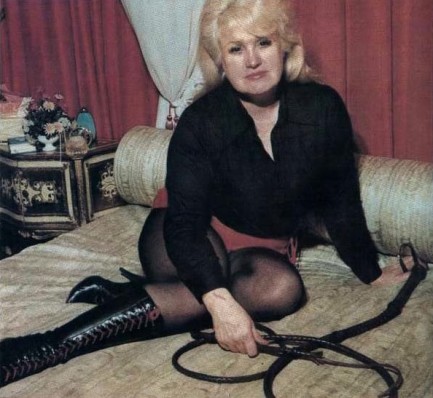 powerful men on her client list of 2,000 (or 10,000, if you believe Confidential) exerted influence on her behalf. The truth is her conviction was overturned after justices noted that the police had neglected to obtain a search warrant. The fact that previous appeals had glossed over this fact is actually indicative of how much influence was arrayed against Von Cleef. In any case, the Supreme Court decision made every piece of evidence police had obtained inadmissible. Without those items there was no proof of lewd conduct on the premises, and Von Cleef had never touched the detective.
powerful men on her client list of 2,000 (or 10,000, if you believe Confidential) exerted influence on her behalf. The truth is her conviction was overturned after justices noted that the police had neglected to obtain a search warrant. The fact that previous appeals had glossed over this fact is actually indicative of how much influence was arrayed against Von Cleef. In any case, the Supreme Court decision made every piece of evidence police had obtained inadmissible. Without those items there was no proof of lewd conduct on the premises, and Von Cleef had never touched the detective.
Von Cleef had been free during this process, using her notoriety to financial advantage. In San Francisco, billed as the Queen of Humliation, she had been giving onstage orations/performances about sado-masochism at a North Beach nightclub called Coke’s. As her case was reaching the Supreme Court, U.S. Immigration was working to deport her—a threat of which Von Cleef was well aware. Thus when she won her appeal and the order came through shortly thereafter to ship her back to her native Netherlands, she had already left the U.S. illegally. Some claim that influential former clients were involved in her deportation, wanting her out of the States where she could do them no harm. That’s possible, but telephones, teletypes, and televisions reached all the way to Holland back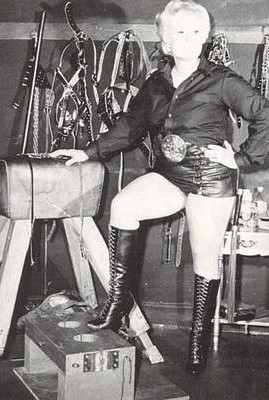 then, which meant that if she had wanted to expose her clients she could just as easily have done it from there. She was deported because that’s what U.S. authorities have always done to alien felons. In Von Cleef’s case, though she had won her appeal, she had overstayed her visa.
then, which meant that if she had wanted to expose her clients she could just as easily have done it from there. She was deported because that’s what U.S. authorities have always done to alien felons. In Von Cleef’s case, though she had won her appeal, she had overstayed her visa.
American tabloids soon moved on to other diversions, and American society followed suit, but Von Cleef maintained a high profile internationally. She opened another dungeon, became a Baroness, wrote a book, appeared in a documentary, and traveled the world promoting her lifestyle. She died in Antwerp, Belgium in 2005, a woman who had gone from nurse to dominatrix, underground to overexposed, and ridden the crazy carousel of American jurisprudence, yet in the end survived and even thrived. One might ask how it was possible, but it seems clear that within her community she was revered from almost the moment she entered it, and she probably enjoyed copious moral and financial support through all her travails. The website dominafiles.com explains best how loyal Von Cleef’s followers were: “What her antagonists didn’t realize was that once an affluent masochist heard about Monique, no matter how, he would travel almost anywhere to see her.”
| The Naked City | Jul 1 2009 |


This July 1, 1967 cover of The Saturday Evening Post shows mass murderer Richard Speck, who, a little less than a year earlier on July 13, 1966, broke into a Chicago townhouse where he raped and killed eight student nurses in a single horrific night. The crime stunned America, and questions about how any man could be so monstrous soon focused on Speck’s brain. At the time of this cover, some genetic researchers thought he was an abnormal 47,XYY karyotype, which was thought to cause hyper-aggression. But Speck was ruled competent to stand trial, was convicted of the murders and sentenced to death, then to life in prison when the U.S. Supreme Court cited irregularities in jury selection during his trial.
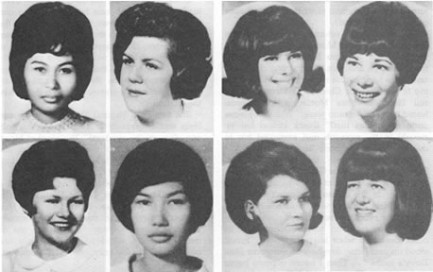 Stateville videotape surfaced—an autopsy revealed that his brain was abnormal after all. His hippocampus and amygdala—the latter of which helps regulate rage and emotional reactions—had fused. Speck was cremated and his ashes were scattered by a newspaper columnist, a fieldhand, and two country employees, who all agreed to keep the location secret forever.
Stateville videotape surfaced—an autopsy revealed that his brain was abnormal after all. His hippocampus and amygdala—the latter of which helps regulate rage and emotional reactions—had fused. Speck was cremated and his ashes were scattered by a newspaper columnist, a fieldhand, and two country employees, who all agreed to keep the location secret forever.



































































